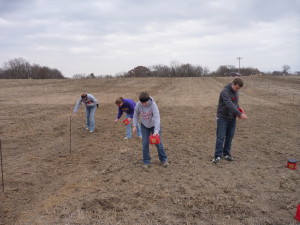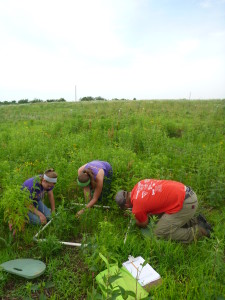Progress So Far
Planning for the Prairies For Agriculture Project began in 2007, and field work began in 2009. Below is a timeline of our progress:
Early Steps – 2009 to 2011
- Marked 378 plots on site.
- Removed existing hay vegetation using herbicide.
- Tilled plots using rented tractor and walk-behind tiller.
- Designed seed mixes.
- Purchased seed from two local dealers.
- Weighed out seed to produce seed mixes for each plot.
Planting – Fall 2011 and Spring 2012
- Seeded fall-planted plots and buffers surrounding research site in October and November, 2011.
- Treated seed to be planted in spring by mixing with moist sand and storing in refrigerator for five weeks. This process, called stratification, is necessary to trigger germination in some seeds.
- Spring planting occurred on the weekend of March 30 – April 1.
- Purchased tractor using money from NSF EPSCoR grant to Iowa State University.
First Two Growing Seasons
- Mowed majority of plots during first growing season – mowed approximately every three weeks, as annual weeds reached a height of 18 inches. Due to drought, only had to mow five times. Un-mowed plots were driven through with tractor to make actual act of mowing the only difference between the plots.
- Controlled several species of invasive plants including sweet clover, wild parsnip, Queen Anne’s lace, and several types of thistles.
- Mowed small number of plots during second growing season. All other plots involved in mowing comparison were driven through with tractor as described above.
Data Collection – Prairie Establishment
- Conducted first data collection in late May and June of first growing season (2012) – counted seedlings in several different kinds of plots – spring versus fall planted plots; mowed versus un-mowed plots; 16 species versus 64 species plots.
- Conducted additional rounds of data collection in summers of 2013, 2014, and 2015 using same procedures as in 2012. Also conducted later round of plant counts in September, and began collecting samples to measure biomass and forage quality.
- Did counts in 2016 – 17 to identify plant species that are aggressive in prairie restorations (see summary of findings on Publications and Presentations Page).
- Conducting drought experiment in 2017 and 2018. Drought impacted our site three of the first six years. To quantify its impact, we picked seven newly planted plots and watered half of each plot during drought conditions in 2017, the first year of growth for these plantings. Counted the number of seedlings on each half twice in 2017; will continue watering if drought conditions return in 2018. Will conduct additional seedling / plant counts in 2018 and will do periodic counts during next decade to follow long term impact of drought.
Data Collection – The Benefits of Prairie
- Conducting research on pollinators from 2016 to 2018. Many pollinators are declining in numbers, but prairie plantings have potential to benefit these vitally important organisms. In 2016 and 17, we compared number of insect pollinators visiting flowers in two kinds of grass-only plots and three different mixes of prairie plantings (low, medium, and high species richness). For results, see summary on Publications and Presentations Page. During 2018, we will examine 50 different species of prairie plants to identify those species that attract the largest and most diverse mix of pollinating insects.
- We have done two medium-scale projects examining the use of plots of varying plant diversity by rodents and other small mammals.
- We have done a pilot project examining forage quality of grasses grown in plots of differing plant diversity.



